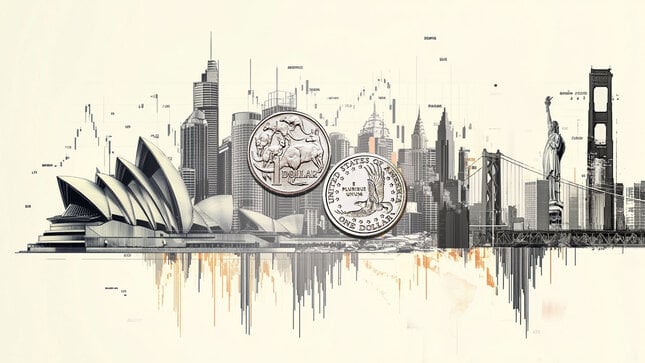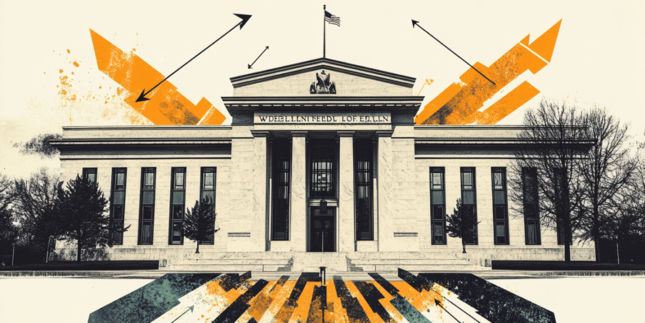Dow Jones Industrial Average Exchange rate
Editors’ Picks

AUD/USD turns sideways around 0.6660 as rally hits pause
The AUD/USD pair turns sideways as the three-week rally hits a pause after posting a fresh three-month high at 0.6686 on Wednesday. During Friday’s early European trading hours, the Aussie pair trades calmly near 0.6660. The pair struggles to extend its advance after the release of the unexpectedly weak Australian labor market data for November.

EUR/USD struggles for direction amid USD gains
EUR/USD is trimming part of its earlier gains, coming under some mild downside pressure near 1.1730 as the US Dollar edges higher. Markets are still digesting the Fed’s latest rate decision, while also looking ahead to more commentary from Fed officials in the sessions ahead.

Gold poised to challenge record highs
Gold prices added roughly 3% in the week, flirting with the $4,350 mark on Friday, to finally settle at around $4,330. Despite its safe-haven condition, the bright metal rallied in a risk-on scenario, amid broad US Dollar weakness.

Week ahead: US NFP and CPI, BoE, ECB and BoJ mark a busy week
After Fed decision, dollar traders lock gaze on NFP and CPI data. Will the BoE deliver a dovish interest rate cut? ECB expected to reiterate “good place” mantra. Will a BoJ rate hike help the yen recover some of its massive losses?

Big week ends with big doubts
The S&P 500 continued to push higher yesterday as the US 2-year yield wavered around the 3.50% mark following a Federal Reserve (Fed) rate cut earlier this week that was ultimately perceived as not that hawkish after all. The cut is especially boosting the non-tech pockets of the market.
Majors
Cryptocurrencies
Signatures
DOW JONES or DJIA
The Dow Jones Industrial Average (DJIA), also called “Dow Jones” or “the Dow” is a price-weighted average of 30 significant stocks traded on the New York Stock Exchange (NYSE), approximately two-thirds of which are represented by companies producing industrial and consumer goods. “Price-weighted” means that each company is assigned a weighting based on its stock price. It was created by The Wall Street Journal editor Charles Dow in 1896.
If the DJIA rises by 10 points comparing to yesterday, it means that the cost of purchasing the 30 stocks in the index today is $10 higher than purchasing those same 30 stocks yesterday, taking into account stock splits and dividends.
Over time, the DJIA can be used as a benchmark for the economy
HISTORIC HIGHS AND LOWS FOR DOW JONES
- All-time records: Max: 29368 on 13/02/2020 - Min: 35.32 on 27/07/1970
- Last 5 years: Max: 29368 on 13/02/2020 - Min: 17282 on 21/08/2015
* Data as of February 2020
ASSETS THAT INFLUENCE THE DOW JONES THE MOST
- Currencies: Oil.
- Commodities: USD, EUR and JPY.
- Bonds: T-Bond (Treasury bond is a marketable, fixed-interest U.S. government debt security).
- Indices: S&P500 (American stock market index based on the market capitalizations of 500 large companies having common stock listed on the NYSE), NASDAQ (benchmark index for U.S. technology stocks), WTI (West Texas Intermediate is a grade of crude oil used as a benchmark in oil pricing, the underlying commodity of NYMEX's oil futures contracts) and RUSSELL 2000 (the most common benchmark for mutual funds that identify themselves as "small-cap").
ORGANIZATIONS, PEOPLE AND ECONOMIC DATA THAT INFLUENCE THE DOW
Since the Dow Jones is a benchmark of American stocks, what will impact its value is related to all those decisions and figures that affect the results of big companies in the United States of America. That is, among others:
- Economic indicators of inflation (CPI, PPI,...), consumer confidence (as Michigan Consumer Confidence Index), growth (GDP), employment (Non Farm Payrolls) and salaries (Average Hourly Wages). An economic indicator is a statistic about an economic activity. Economic indicators allow analysis of economic performance and predictions of future performance.
- interest rates decided by the Federal Reserve System (Fed) which is the central banking system of the United States of America. It was created on December 23, 1913, with the enactment of the Federal Reserve Act, after a series of financial panics led to the desire for central control of the monetary system in order to alleviate financial crises. Jerome Powell is the 16th Chair of the Fed.
- Fiscal policy, trade deals, business laws decided by the US administration (Donald Trump, the 45th, 47th and current president of the United States, assuming office on January 20, 2025), but also by the US Treasury Department (Scott Bessent, serving as the United States Secretary of the Treasury as part of the Cabinet of Donald Trump) and the US Department of Commerce which is an executive department of the federal government concerned with promoting economic growth (Jeremy Pelter, United States Secretary of Commerce).
- Energy prices (electricity, oil,...), because they have impact on production costs for those companies. A fixed-rate tariff sets the cost of energy for a certain amount of time, while prices on a variable tariff can go up or down according to the market. The price of energy depends on a range of different supply and demand conditions, including the geopolitical situation, the national energy mix, import diversification, network costs, environmental protection costs, etc...